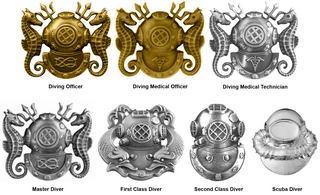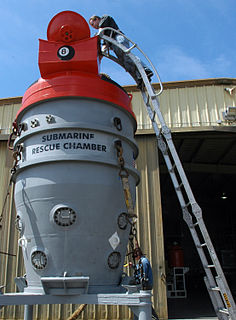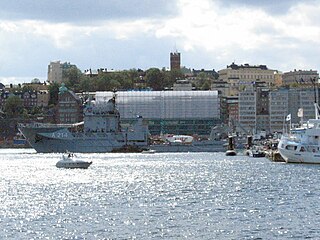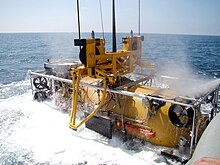
A remotely operated underwater vehicle is a tethered underwater mobile device, commonly called underwater robot.

A midget submarine is any submarine under 150 tons, typically operated by a crew of one or two but sometimes up to six or nine, with little or no on-board living accommodation. They normally work with mother ships, from which they are launched and recovered and which provide living accommodation for the crew and support staff.

A deep-submergence vehicle (DSV) is a deep-diving crewed submersible that is self-propelled. Several navies operate vehicles that can be accurately described as DSVs. DSVs are commonly divided into two types: research DSVs, which are used for exploration and surveying, and DSRVs, which can be used for rescuing the crew of a sunken navy submarine, clandestine (espionage) missions, or both. DSRVs are equipped with docking chambers to allow personnel ingress and egress via a manhole.

Trieste II(DSV-1) was the successor to Trieste—the United States Navy's first bathyscaphe purchased from its Swiss designers.

The Scorpio is a brand of underwater submersible Remotely Operated Vehicle (ROV) manufactured by Perry Tritech used by sub-sea industries such as the oil industry for general operations, and by the Royal Navy and the United States Navy for submarine rescue services. Originally developed by AMETEK Straza of El Cajon, United States, they were subsequently developed by Perry Tritech. Although the design of the original Scorpio is over several decades old, it forms the basis for a current generation of Scorpio-branded ROVs. Scorpio ROVs are named in a sequence following the order of manufacture, such as "Scorpio 17" or "Scorpio 45" which refer to specific ROVs.

A diving chamber is a vessel for human occupation, which may have an entrance that can be sealed to hold an internal pressure significantly higher than ambient pressure, a pressurised gas system to control the internal pressure, and a supply of breathing gas for the occupants.

A deep-submergence rescue vehicle (DSRV) is a type of deep-submergence vehicle used for rescue of downed submarines and clandestine missions. While DSRV is the term most often used by the United States Navy, other nations have different designations for their vehicles.

DSRV-2Avalon was a Mystic-class deep-submergence rescue vehicle rated to dive up to 5000 feet to rescue submarine crews trapped deep under the sea. The submarine was acquired in response to the loss of the USS Thresher, so that the Navy would have a way to rescue trapped submarine crews.
DSV-4 is a 25-ton, crewed deep-ocean research submersible owned by the United States Navy, now known only by its hull number, not by its former name.

The United States Navy master diver is the highest warfare qualification obtainable by a member of U.S. Navy diving community. A master diver is an enlisted person who typically has the most experience and knowledge on all aspects of diving and underwater salvage.

DSRV-1Mystic is a deep-submergence rescue vehicle that is rated to dive up to 5,000 feet. It was built by Lockheed for the US Navy at a construction cost of $41 million and launched 24 January 1970. It was declared fully operational in 1977 and named Mystic.
Unmanned underwater vehicles (UUV), sometimes known as underwater drones, are submersible vehicles that can operate underwater without a human occupant. These vehicles may be divided into two categories: remotely operated underwater vehicles (ROUVs) and autonomous underwater vehicles (AUVs). ROUVs are remotely controlled by a human operator. AUVs are automated and operate independently of direct human input.
Australian Submarine Rescue Vehicle Remora was a submarine rescue vehicle used by the Royal Australian Navy (RAN) between 1995 and 2006. The name comes from the remora, a small fish that can attach itself to larger marine life, and has the backronym "Really Excellent Method of Rescuing Aussies".

Submarine Escape Immersion Equipment (SEIE), also known as Submarine Escape and Immersion Equipment, is a whole-body suit and one-man life raft that was first produced in 1952. It was designed by British company RFD Beaufort Limited and allows submariners to escape from a sunken submarine. The suit also provides protection against hypothermia and has replaced the Steinke hood rescue device. The suit allows survivors to escape a disabled submarine at depths down to 600 feet (183 m), with an ascent speed of 2–3 meters/second, at a rate of eight or more sailors per hour.

The United States Navy Experimental Diving Unit is the primary source of diving and hyperbaric operational guidance for the US Navy. It is located within the Naval Support Activity Panama City in Panama City Beach, Bay County, Florida.

The McCann Submarine Rescue Chamber is a device for rescuing submariners from a submarine that is unable to surface.

URF is the Royal Swedish Navy’s Submarine Rescue Vessel.
USSP is a planned Submarine rescue ship of the Marina Militare, financed with 2017's balance law.
It is expected to replace Italian ship Anteo.

DSV-5, ex-NEMO, was a submersible used by the United States Navy between 1970 and 1986 to oversee and observe undersea construction work. NEMO had a spherical transparent acrylic hull, which gave occupants panoramic vision. NEMO was the first submersible with a hull made entirely out of transparent acrylic (Plexiglass), and much of her career was spent testing this hull design. NEMO was found to be an effective observation platform, despite not being able to hover in place, and acrylic-hulled submersibles have continued to be built and operated in the United States. NEMO is considered part of the Alvin class of Deep Submergence Vehicles despite bearing little resemblance to the other subs of the class. NEMO was transferred to "other government agencies" in 1986 and retired from government service in 2011. It was then given to the U.S. Navy Seabee Museum, where it remains on display.
Submarine rescue is the process of locating a sunk submarine with survivors on board, and bringing the survivors to safety. This may be done by recovering the vessel to the surface first, or by transferring the trapped personnel to a rescue bell or deep-submergence rescue vehicle to bring them to the surface. Submarine rescue may be done at pressures between ambient at depth, and sea level atmospheric pressure, depending on the condition of the distressed vessel and the equipment used for the rescue. Self-rescue of submarine personnel by buoyant free ascent at ambient pressure is considered submarine escape. Survivors may require recompression treatment for decompression illness.














